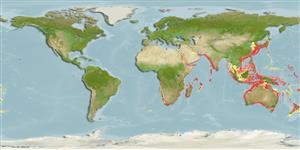Environment: milieu / climate zone / depth range / distribution range
Ecology
Marine; reef-associated; depth range 40 - 421 m (Ref. 11441). Deep-water
Indo-Pacific: Red Sea to South Africa, Oman, Arabian Sea, Australia, Japan, Taiwan and the Philippines. Reported from Malaysia (Ref. 5756) and Indonesia (Ref. 5978).
Size / Weight / Age
Maturity: Lm ? range ? - ? cm
Max length : 42.0 cm TL male/unsexed; (Ref. 9710); common length : 20.0 cm SL male/unsexed; (Ref. 9864)
Dorsal spines (total): 4; Dorsal soft rays (total): 25 - 27; Anal spines: 3; Anal soft rays: 8 - 10. Small specimens pale with dark blotches on body, dorsal, anal and pelvic fins becoming larger and coalescing with growth; adults dark with narrow, pale, vertical bands (Ref. 5449).
Inhabits deep rocky reefs (Ref. 9710, 11230).
Life cycle and mating behavior
Maturity | Reproduction | Spawning | Eggs | Fecundity | Larvae
Heemstra, P.C., 1997. Pentacerotidae. Armourheads. In K.E. Carpenter and V. Niem (eds.) FAO Identification Guide for Fishery Purposes. The Western Central Pacific. (Ref. 9864)
IUCN Red List Status (Ref. 130435: Version 2024-1)
Threat to humans
Harmless
Human uses
Fisheries: commercial
Tools
Special reports
Download XML
Internet sources
Estimates based on models
Preferred temperature (Ref.
123201): 12.9 - 26.4, mean 19 °C (based on 678 cells).
Phylogenetic diversity index (Ref.
82804): PD
50 = 1.0001 [Uniqueness, from 0.5 = low to 2.0 = high].
Bayesian length-weight: a=0.01995 (0.00906 - 0.04395), b=3.01 (2.83 - 3.19), in cm total length, based on all LWR estimates for this body shape (Ref.
93245).
Trophic level (Ref.
69278): 3.5 ±0.50 se; based on food items.
Resilience (Ref.
120179): Low, minimum population doubling time 4.5 - 14 years (Preliminary K or Fecundity.).
Fishing Vulnerability (Ref.
59153): Low to moderate vulnerability (32 of 100).
Nutrients (Ref.
124155): Calcium = 11.2 [4.4, 21.0] mg/100g; Iron = 0.242 [0.105, 0.524] mg/100g; Protein = 18.4 [17.0, 19.7] %; Omega3 = 0.189 [0.093, 0.392] g/100g; Selenium = 11.3 [4.1, 28.6] μg/100g; VitaminA = 22.1 [3.4, 140.7] μg/100g; Zinc = 0.358 [0.215, 0.567] mg/100g (wet weight);
